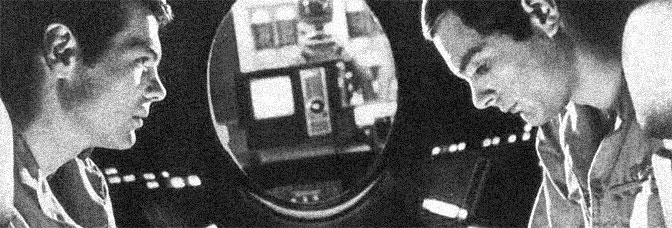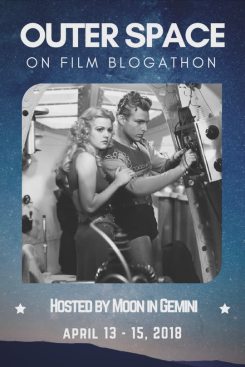2001: A Space Odyssey has five distinct parts–the “Dawn of Man” sequence, then the space station and moon visit, then the main action before the intermission, then the main action after the intermission, then the “Jupiter” sequence. The prehistoric sequence, where an advanced alien device puts the vegetarian, prey-to-carnivores missing links on track to become carnivorous and murderous human beings. Given the setting and characters, it’s no surprise Kubrick changes style a bit when he gets to the future. 2001 starts with a shot of the planets aligning, then goes to the missing links. Kubrick visibly changes the film’s presumable trajectory. The prehistoric stop-off.
That sequence is done in vignettes, the first time editor Ray Lovejoy gets to astound. Kubrick characterizes the apes, but never anthropomorphizes them. The film establishes their regular lives–bickering with boars for plants, bickering with other tribes for water, getting killed off by hungry big cats. Kubrick and Lovejoy hold each shot just long enough. Kubrick establishes mood, then reveals the narrative. But he never gets overenthusiastic for big events; even with 2001’s always magnificent sometimes dramatic choice of music, the visual pacing of the film never changes. The music accompanies, never dictates (which leads to some interesting effects in the second section).
That second section follows scientist, bureaucrat, and questionably dedicated father William Sylvester to the moon. Lots of beautiful filmmaking here, the music against the exquisite, ageless, and all around perfect special effects sequences. Spaceships, space stations, the Earth, the moon. It’s magnificent. It’s also where Kubrick lets himself have a laugh or two. If not a laugh, then at least a smile. Because despite 2001 being a literal travelogue of the future in the Sylvester section, Kubrick’s got no interest in exposition. Except when it develops Sylvester’s character and reveals the strangeness of future folk. But Kubrick is interested in doing the travelogue–so there are lots of things with instructions, lots of placards. Lingering shots, giving the viewer long enough to consider the possibilities. And the ten steps to the zero g toilet.
And through most of the second section, 2001 feels very epical. Sure, the first part of the movie was doing a serious ape-man prologue, but there’s rising action in the second part. There’s mystery. There’s Sylvester maybe forgetting about his daughter’s birthday. There are Russians. There’s bureaucracy. The Sylvester as bureaucrat scenes are so weird, in such a good way. Kubrick and Arthur C. Clarke’s script saves the best dialogue for the main action and for someone in particular, but the future decorum in the Sylvester section is peculiar, intriguing, and wonderful.
Shame it doesn’t turn out to be the main plot. When 2001 cuts from ape-men to space men, it does so with a lot of grace. When it cuts from space bureaucrats to space explorers, it’s done so with metal machine music.
Besides having a single setting–the Discovery spaceship–and a set cast (bland leading man types Keir Dullea and Gary Lockwood and then the red eyed computer, voiced by Douglas Rain), the third section also has an entirely different feel, visually and aurally. The tone of the music has changed. It’s still lush, but it’s not magnificent. Because space is empty in the third and fourth sections of the film. It’s empty, it’s quiet, and it’s lonely.
Kubrick and Clarke quickly establish the setting and characters, doing so as part of a lengthy summary montage. Kubrick’s expository interest is a little different now. The second section was the commercial for space travel, the third section is the lonely reality for Lockwood and Dullea. It’s also the section where Kubrick shows off the most with the interior special effects. There’s a lot of exterior stuff in the second part, but the third and fourth parts just have the one or two spacecraft. It’s otherwise empty space. So the future gawking is on the interiors, with all sorts of gravity-related design choices. And it’s all just functional. Dullea and Lockwood just getting through another day.
But, really, Kubrick is just setting up the computer to be a full character. That omnipresent red eye. Rain’s soothing, dulcet voice. Kubrick and Lovejoy cut Rain’s scenes–and Dullea and Lockwood’s interactions with him–deliberately, with a lot of time for deliberation, as Dullea and Lockwood (and the cast) wonder what Rain is really thinking. Except it’s just that voice and that red eye.
The fourth section has the same setting, same cast, no music, completely different editing pace. It’s got the action, it’s got the drama; it’s got the Frankenstein. And it’s also got completely different needs of the cast. Well, Dullea and Lockwood anyway. When things go wrong, Kubrick and Clarke don’t offer any expository outbursts. The quiet of the fourth section extends to the characters–they work intensely and silently.
The third and fourth parts have their own epical build too. Yes, the style changes after intermission, but not the narrative drive. Except it turns out Kubrick’s not really interested in that narrative drive. He’s had action in exterior prehistoric, exterior future, and interior future. For part five, most of it, the film is a point-of-view shot as the explorer encounters the unimaginable. Kubrick starts with special effects shots, then moves on to photographic process ones. For ten minutes, the film mesmerizes, free of time, free of plot. But with music again. Music comes back for part five.
Rain’s performance is a startling creation. Rain, Kubrick, Lovejoy, cinematographer Geoffrey Unsworth, whoever came up with the red eye. It’s an achievement and probably the film’s finest. Maybe the finest. There are quite a few achievements happening in 2001; big ones, little ones. Technical ones (so many technical ones), narrative ones (many less of these, but significant ones). But Rain and the red eye, it’s where Kubrick excels. Kubrick shows off a lot in 2001, but never with HAL.
Dullea and Lockwood are good. Dullea’s a little better. Sylvester’s good. Lead ape-man Daniel Richter is good. Technically it’s fabulous. Lovejoy’s editing keeps getting better; the fifth section needs a lot of cutting and Lovejoy’s always got the right one. Unsworth’s photography is great. Production design is great. 2001 is a phenomenal film.
 ★★★★
★★★★
CREDITS
Produced and directed by Stanley Kubrick; screenplay by Kubrick and Arthur C. Clarke, based on a short story by Clarke; director of photography, Geoffrey Unsworth; edited by Ray Lovejoy; production designers, Ernest Archer, Harry Lange, and Anthony Masters; released by Metro-Goldwyn-Mayer.
Starring Keir Dullea (Dr. Dave Bowman), Gary Lockwood (Dr. Frank Poole), William Sylvester (Dr. Haywood R. Floyd), Daniel Richter (Moon-Watcher), Leonard Rossiter (Dr. Andrei Smyslov), Margaret Tyzack (Elena), Robert Beatty (Dr. Ralph Halvorsen), Sean Sullivan (Dr. Bill Michaels), and Douglas Rain (HAL 9000).


Leave a reply to Debbie Cancel reply